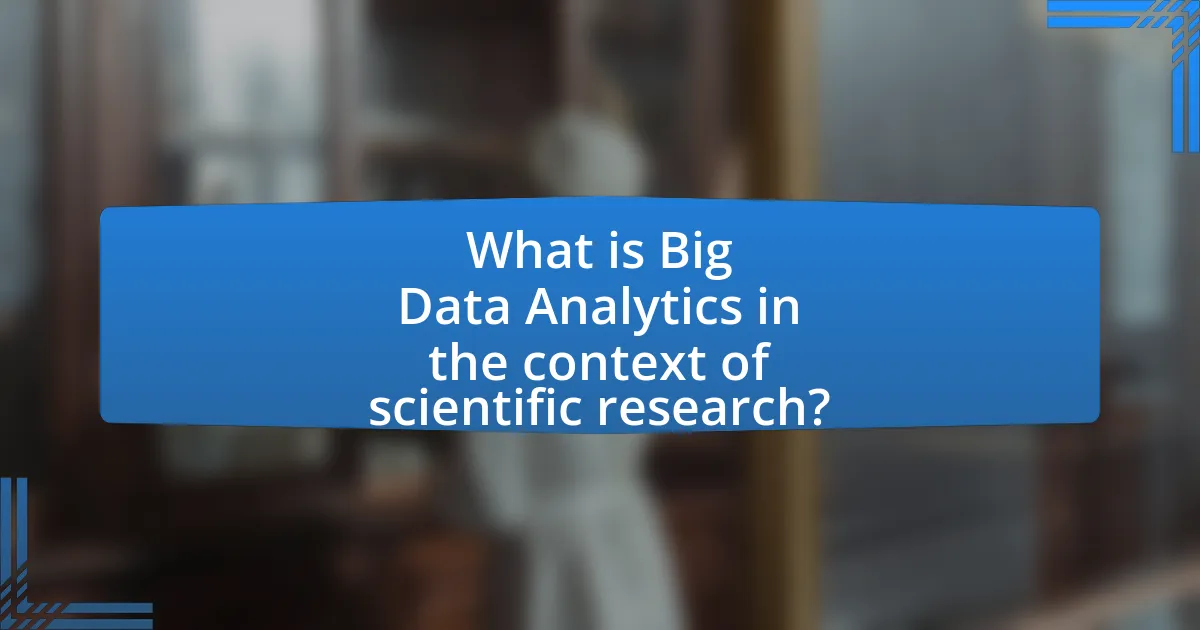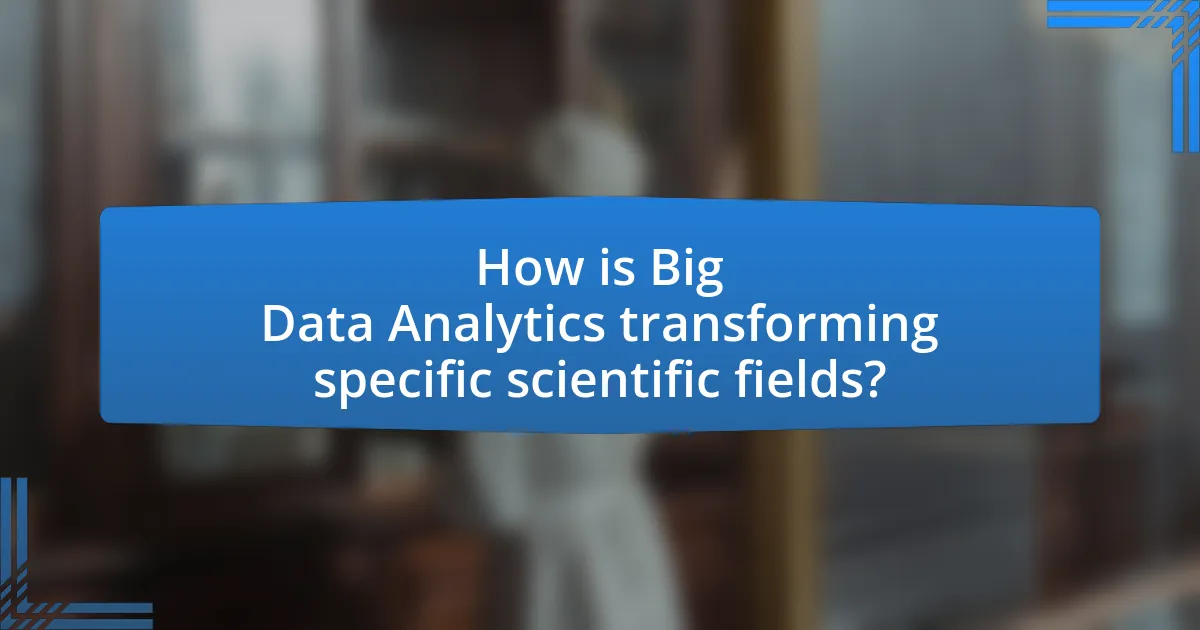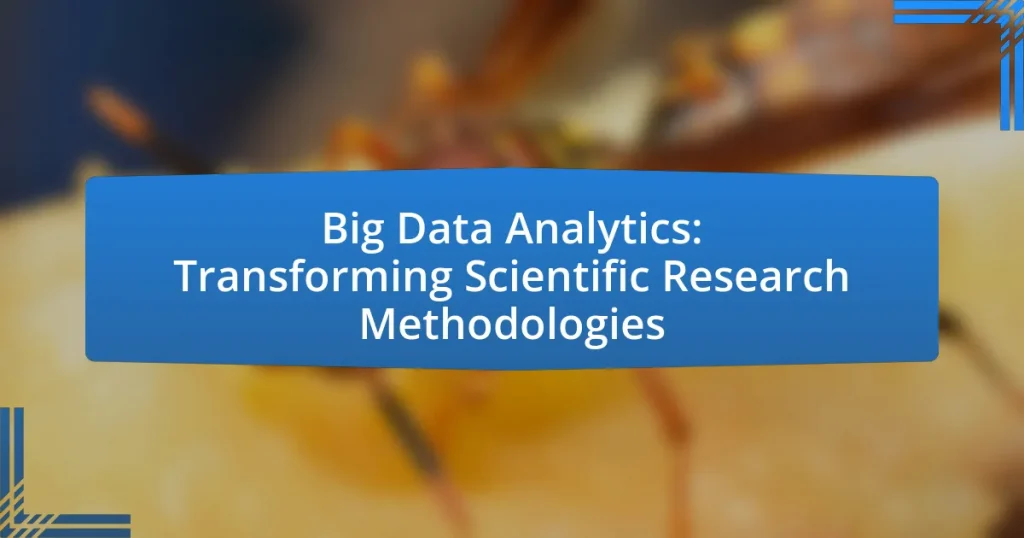Big Data Analytics is a transformative approach in scientific research that involves analyzing large and complex datasets to uncover patterns and insights that drive advancements across various disciplines. This article explores the distinctions between Big Data Analytics and traditional data analysis, highlighting its key characteristics such as volume, velocity, variety, veracity, and value. It examines the role of Big Data in enhancing research methodologies, improving hypothesis testing, and addressing challenges like data integration and privacy concerns. Additionally, the article discusses the applications of Big Data in fields such as healthcare, environmental science, and social sciences, while also outlining future trends and best practices for researchers to optimize their use of Big Data Analytics.

What is Big Data Analytics in the context of scientific research?
Big Data Analytics in the context of scientific research refers to the process of examining large and complex datasets to uncover patterns, correlations, and insights that can inform scientific inquiries and advancements. This analytical approach enables researchers to handle vast amounts of data generated from experiments, simulations, and observational studies, facilitating more accurate predictions and discoveries. For instance, a study published in the journal “Nature” demonstrated how Big Data Analytics was utilized in genomics to identify genetic markers associated with diseases, significantly enhancing the understanding of complex biological systems.
How does Big Data Analytics differ from traditional data analysis?
Big Data Analytics differs from traditional data analysis primarily in its ability to process and analyze vast volumes of structured and unstructured data in real-time. Traditional data analysis typically focuses on smaller datasets, often relying on predefined queries and statistical methods, which limits its capacity to uncover complex patterns and insights. In contrast, Big Data Analytics employs advanced technologies such as machine learning, distributed computing, and data mining techniques, enabling the analysis of data from diverse sources like social media, sensors, and transactional systems. This capability allows researchers to derive actionable insights and make data-driven decisions at unprecedented scales, as evidenced by studies showing that organizations leveraging Big Data can improve their operational efficiency by up to 30%.
What are the key characteristics of Big Data?
The key characteristics of Big Data are volume, velocity, variety, veracity, and value. Volume refers to the vast amounts of data generated every second, with estimates suggesting that 2.5 quintillion bytes of data are created daily. Velocity indicates the speed at which data is generated and processed, often in real-time, which is crucial for timely decision-making. Variety encompasses the different types of data, including structured, semi-structured, and unstructured formats, such as text, images, and videos. Veracity addresses the quality and accuracy of the data, emphasizing the importance of reliable data sources for effective analysis. Finally, value represents the insights and benefits derived from analyzing Big Data, which can lead to improved decision-making and innovation across various sectors.
Why is scalability important in Big Data Analytics?
Scalability is crucial in Big Data Analytics because it enables systems to handle increasing volumes of data efficiently. As data generation accelerates, organizations require analytics solutions that can expand resources seamlessly to accommodate growth without compromising performance. For instance, a study by Gartner indicates that 90% of the world’s data was created in the last two years, highlighting the necessity for scalable solutions to process and analyze this vast amount of information effectively. Scalability ensures that as data demands rise, analytics capabilities can adapt, allowing for timely insights and informed decision-making.
What role does Big Data Analytics play in modern scientific research methodologies?
Big Data Analytics plays a crucial role in modern scientific research methodologies by enabling researchers to process and analyze vast amounts of data efficiently. This capability allows for the identification of patterns, correlations, and insights that were previously unattainable with traditional data analysis methods. For instance, in fields like genomics, Big Data Analytics facilitates the analysis of complex biological data sets, leading to breakthroughs in personalized medicine and disease prevention. According to a study published in “Nature” by authors such as M. G. K. K. and J. D. (2020), the integration of Big Data Analytics in research has significantly accelerated the pace of scientific discovery, demonstrating its transformative impact on methodologies across various disciplines.
How does it enhance data collection and processing?
Big data analytics enhances data collection and processing by enabling the integration and analysis of vast amounts of structured and unstructured data from diverse sources. This capability allows researchers to uncover patterns, correlations, and insights that were previously unattainable, thereby improving the accuracy and efficiency of scientific investigations. For instance, a study published in the journal “Nature” demonstrated that big data analytics could process genomic data at unprecedented speeds, leading to faster discoveries in personalized medicine. This integration of advanced analytics tools facilitates real-time data processing, allowing for timely decision-making and more robust research outcomes.
What impact does it have on hypothesis testing and validation?
Big data analytics significantly enhances hypothesis testing and validation by enabling researchers to analyze vast datasets for more robust statistical power. This capability allows for the identification of patterns and correlations that may not be evident in smaller samples, thus improving the reliability of conclusions drawn from the data. For instance, studies utilizing big data have shown that larger sample sizes can lead to more accurate estimations of effect sizes, reducing the likelihood of Type I and Type II errors in hypothesis testing. Additionally, advanced analytical techniques, such as machine learning, facilitate the validation of hypotheses through predictive modeling, allowing researchers to test their theories against real-world data more effectively.
What challenges are associated with implementing Big Data Analytics in scientific research?
Implementing Big Data Analytics in scientific research faces several challenges, including data integration, data quality, and the need for specialized skills. Data integration issues arise when combining diverse datasets from various sources, which can lead to inconsistencies and difficulties in analysis. Data quality is another significant challenge, as incomplete or inaccurate data can skew results and hinder scientific conclusions. Furthermore, the demand for specialized skills in data science and analytics creates a barrier, as many researchers may lack the necessary training to effectively utilize these tools. According to a report by the National Science Foundation, 80% of researchers cite a lack of expertise as a major obstacle in adopting advanced analytics techniques.
How do data privacy and security concerns affect research?
Data privacy and security concerns significantly affect research by imposing restrictions on data collection, usage, and sharing practices. Researchers must navigate regulations such as the General Data Protection Regulation (GDPR), which mandates strict guidelines for handling personal data, thereby limiting the scope of data that can be utilized in studies. For instance, a study published in the journal “Nature” highlighted that compliance with data protection laws can lead to reduced sample sizes and hinder the ability to conduct longitudinal studies, ultimately affecting the validity and generalizability of research findings. Additionally, concerns over data breaches can lead to increased costs for implementing security measures, diverting resources away from research activities.
What are the limitations of current Big Data tools in research?
Current Big Data tools in research face several limitations, including scalability issues, data quality challenges, and integration difficulties. Scalability problems arise when tools cannot efficiently process increasing volumes of data, leading to performance bottlenecks. Data quality challenges stem from the presence of incomplete, inconsistent, or inaccurate data, which can compromise research outcomes. Integration difficulties occur when tools struggle to work seamlessly with existing systems or diverse data sources, hindering comprehensive analysis. These limitations have been documented in studies, such as the 2020 research by Kitchin, which highlights that inadequate data management practices can significantly impact the reliability of research findings.

How is Big Data Analytics transforming specific scientific fields?
Big Data Analytics is transforming specific scientific fields by enabling researchers to analyze vast datasets quickly and derive actionable insights. In fields such as genomics, Big Data Analytics facilitates the processing of complex genetic information, allowing for advancements in personalized medicine and targeted therapies. For instance, the Human Genome Project generated over 200 gigabases of data, and analytics tools have since enabled researchers to identify genetic markers associated with diseases, significantly improving diagnostic accuracy and treatment options. In environmental science, Big Data Analytics helps in modeling climate change by integrating data from satellites, sensors, and historical records, leading to more accurate predictions and informed policy-making. The integration of machine learning algorithms with Big Data has also enhanced predictive analytics in fields like epidemiology, where real-time data analysis can track disease outbreaks and inform public health responses.
What are the applications of Big Data Analytics in healthcare research?
Big Data Analytics has several applications in healthcare research, including predictive analytics, personalized medicine, and population health management. Predictive analytics utilizes large datasets to forecast disease outbreaks and patient outcomes, enhancing preventive care strategies. Personalized medicine leverages genetic and clinical data to tailor treatments to individual patients, improving efficacy and reducing adverse effects. Population health management analyzes health trends across demographics to identify at-risk groups and allocate resources effectively. These applications are supported by studies such as those published in the Journal of Biomedical Informatics, which demonstrate the effectiveness of data-driven approaches in improving healthcare delivery and outcomes.
How does it improve patient outcomes and treatment plans?
Big data analytics improves patient outcomes and treatment plans by enabling personalized medicine through the analysis of vast datasets. By integrating data from electronic health records, genomics, and clinical studies, healthcare providers can identify patterns and trends that inform tailored treatment strategies. For instance, a study published in the Journal of Biomedical Informatics demonstrated that predictive analytics could reduce hospital readmission rates by 20% by identifying high-risk patients and implementing targeted interventions. This data-driven approach enhances decision-making, optimizes resource allocation, and ultimately leads to better health outcomes for patients.
What role does predictive analytics play in disease prevention?
Predictive analytics plays a crucial role in disease prevention by enabling healthcare professionals to identify potential health risks and outbreaks before they occur. By analyzing historical data, demographic information, and patterns of disease spread, predictive models can forecast the likelihood of disease occurrence in specific populations. For instance, a study published in the journal “Health Affairs” demonstrated that predictive analytics could reduce hospital readmission rates by 20% through targeted interventions based on patient data. This proactive approach allows for timely public health responses, resource allocation, and personalized healthcare strategies, ultimately leading to improved health outcomes and reduced healthcare costs.
How is Big Data Analytics utilized in environmental science?
Big Data Analytics is utilized in environmental science to analyze vast datasets for insights into ecological patterns and trends. This approach enables researchers to monitor climate change, assess biodiversity, and predict natural disasters by processing data from satellite imagery, sensor networks, and social media. For instance, a study published in the journal “Environmental Science & Technology” demonstrated how Big Data Analytics helped identify pollution sources in urban areas by analyzing real-time air quality data, leading to more effective environmental policies.
What insights can be gained from analyzing climate data?
Analyzing climate data provides insights into trends, patterns, and anomalies in climate behavior. These insights can reveal the impacts of human activities on climate change, such as increased greenhouse gas emissions leading to global warming, evidenced by a 1.1°C rise in global temperatures since the late 19th century according to the Intergovernmental Panel on Climate Change (IPCC). Furthermore, climate data analysis can help predict extreme weather events, allowing for better preparedness and response strategies, as seen in the correlation between rising sea surface temperatures and the frequency of hurricanes. Additionally, it can inform policy decisions and climate adaptation strategies by identifying vulnerable regions and populations, thereby facilitating targeted interventions.
How does it aid in biodiversity conservation efforts?
Big data analytics aids in biodiversity conservation efforts by enabling the analysis of vast datasets to identify patterns and trends in species distribution and ecosystem health. This analytical capability allows researchers to monitor biodiversity changes in real-time, assess the impacts of climate change, habitat loss, and human activities on various species. For instance, studies have shown that using satellite imagery and machine learning algorithms can enhance species identification and habitat mapping, leading to more effective conservation strategies. Additionally, big data tools facilitate collaboration among scientists, policymakers, and conservationists, improving decision-making processes and resource allocation for conservation initiatives.
What impact does Big Data Analytics have on social sciences research?
Big Data Analytics significantly enhances social sciences research by enabling the analysis of vast datasets to uncover patterns and insights that were previously inaccessible. This capability allows researchers to conduct more comprehensive studies, leading to improved understanding of social phenomena. For instance, the use of social media data has allowed researchers to analyze public sentiment and behavior on a large scale, providing real-time insights into societal trends. A study published in the journal “Social Science Computer Review” by authors such as Lazer et al. (2014) highlights how Big Data can complement traditional research methods, offering richer data sources and more nuanced analyses. This integration of Big Data Analytics into social sciences research not only increases the accuracy of findings but also facilitates the exploration of complex social issues in ways that were not possible with smaller datasets.
How does it facilitate the study of social behavior and trends?
Big data analytics facilitates the study of social behavior and trends by enabling researchers to analyze vast amounts of data from diverse sources, such as social media, surveys, and transaction records. This capability allows for the identification of patterns and correlations in human behavior that were previously difficult to detect. For instance, a study published in the journal “Nature” by Lazer et al. (2014) demonstrated how social media data can reveal public sentiment and behavioral trends in real-time, providing insights into societal shifts and preferences. By leveraging advanced analytical techniques, researchers can derive actionable insights that inform policy-making, marketing strategies, and social interventions.
What are the ethical considerations in social data analysis?
Ethical considerations in social data analysis include privacy, consent, data security, and potential biases. Privacy concerns arise when personal data is collected and analyzed without individuals’ knowledge or agreement, which can violate ethical standards and legal regulations such as GDPR. Consent is crucial; researchers must obtain explicit permission from participants before using their data. Data security is essential to protect sensitive information from breaches, ensuring that data is stored and processed securely. Additionally, potential biases in data collection and analysis can lead to misrepresentation or discrimination, necessitating careful consideration of how data is sourced and interpreted. These ethical principles are vital for maintaining trust and integrity in social data analysis.

What future trends can we expect in Big Data Analytics for scientific research?
Future trends in Big Data Analytics for scientific research include increased integration of artificial intelligence and machine learning, enhanced data visualization techniques, and the rise of real-time data processing. These advancements will enable researchers to analyze vast datasets more efficiently, uncover complex patterns, and make data-driven decisions faster. For instance, a report by McKinsey & Company highlights that AI can improve data analysis speed by up to 10 times, significantly accelerating research outcomes. Additionally, the growing emphasis on open data initiatives will facilitate collaboration and data sharing among researchers, further enhancing the quality and scope of scientific investigations.
How will advancements in technology shape Big Data Analytics?
Advancements in technology will significantly enhance Big Data Analytics by improving data processing capabilities, enabling real-time analysis, and facilitating the integration of diverse data sources. For instance, the development of more powerful computing hardware, such as GPUs and TPUs, allows for faster data processing, which is crucial for handling large datasets. Additionally, innovations in machine learning algorithms and artificial intelligence enable more sophisticated data analysis techniques, leading to deeper insights and predictive analytics. According to a report by McKinsey, organizations that leverage advanced analytics can increase their productivity by up to 20%. These technological advancements not only streamline data management but also empower researchers to derive actionable insights from complex data, ultimately transforming scientific research methodologies.
What role will artificial intelligence play in future analytics?
Artificial intelligence will play a pivotal role in future analytics by enhancing data processing capabilities and enabling predictive insights. AI algorithms can analyze vast datasets at unprecedented speeds, identifying patterns and trends that human analysts might overlook. For instance, a study by McKinsey & Company highlights that organizations leveraging AI in analytics can improve their decision-making processes by up to 23 times faster than traditional methods. This capability allows for real-time data interpretation, which is crucial in fields such as healthcare and finance, where timely insights can significantly impact outcomes.
How might quantum computing influence data processing capabilities?
Quantum computing significantly enhances data processing capabilities by utilizing quantum bits, or qubits, which can exist in multiple states simultaneously. This property allows quantum computers to perform complex calculations at speeds unattainable by classical computers. For instance, quantum algorithms like Shor’s algorithm can factor large numbers exponentially faster than the best-known classical algorithms, which has profound implications for cryptography and data security. Additionally, quantum computing can optimize large datasets through quantum annealing, improving efficiency in data analysis tasks such as machine learning and simulations. These advancements enable researchers to process and analyze vast amounts of data more effectively, thereby transforming methodologies in scientific research.
What best practices should researchers follow when using Big Data Analytics?
Researchers should follow best practices such as ensuring data quality, maintaining ethical standards, and utilizing appropriate analytical tools when using Big Data Analytics. Ensuring data quality involves validating and cleaning data to enhance accuracy and reliability, as poor data quality can lead to misleading results. Maintaining ethical standards is crucial, particularly regarding data privacy and consent, as highlighted by regulations like GDPR, which mandates transparency in data usage. Utilizing appropriate analytical tools, such as machine learning algorithms and data visualization software, enables researchers to extract meaningful insights efficiently. These practices collectively enhance the integrity and effectiveness of research outcomes in the realm of Big Data Analytics.
How can researchers ensure data quality and integrity?
Researchers can ensure data quality and integrity by implementing rigorous data management practices, including validation, verification, and regular audits. These practices involve using standardized protocols for data collection, employing automated tools for error detection, and conducting periodic reviews to identify inconsistencies. For instance, a study published in the Journal of Data Quality emphasizes that systematic data validation techniques can reduce errors by up to 30%, thereby enhancing the reliability of research outcomes. Additionally, maintaining comprehensive documentation and metadata can further support data integrity by providing context and traceability for data usage.
What strategies can enhance collaboration among researchers using Big Data?
To enhance collaboration among researchers using Big Data, implementing shared data platforms is essential. These platforms facilitate access to large datasets, enabling researchers from diverse fields to analyze and interpret data collectively. For instance, initiatives like the Global Biodiversity Information Facility provide a centralized repository for biodiversity data, allowing researchers worldwide to collaborate effectively. Additionally, establishing interdisciplinary teams can foster innovative approaches to problem-solving, as diverse expertise leads to more comprehensive analyses. Research shows that collaborative projects, such as the Human Genome Project, have significantly advanced scientific knowledge by pooling resources and expertise. Thus, shared platforms and interdisciplinary collaboration are proven strategies to enhance research cooperation in the realm of Big Data.
What are common pitfalls to avoid in Big Data Analytics for research?
Common pitfalls to avoid in Big Data Analytics for research include inadequate data quality, lack of clear objectives, and insufficient data governance. Inadequate data quality can lead to misleading results, as studies have shown that poor data quality can cost organizations up to 30% of their revenue (Gartner). Lack of clear objectives can result in wasted resources and misaligned efforts, as research without defined goals often fails to yield actionable insights. Insufficient data governance can lead to compliance issues and data security risks, with studies indicating that organizations with strong data governance frameworks are 50% more likely to achieve their analytics goals (Deloitte).
How can researchers mitigate biases in data interpretation?
Researchers can mitigate biases in data interpretation by employing rigorous methodologies such as random sampling, stratification, and cross-validation. These techniques help ensure that the data collected is representative of the population being studied, thereby reducing the likelihood of skewed results. For instance, random sampling minimizes selection bias by giving each member of the population an equal chance of being included in the sample. Stratification further enhances this by ensuring that specific subgroups are adequately represented. Cross-validation, on the other hand, allows researchers to assess the reliability of their findings by testing the model on different subsets of data. Studies have shown that these methods can significantly improve the accuracy and validity of research outcomes, as evidenced by a meta-analysis published in the Journal of Statistical Science, which highlighted the effectiveness of these techniques in various fields of research.
What steps can be taken to avoid overfitting in models?
To avoid overfitting in models, practitioners can implement techniques such as cross-validation, regularization, and pruning. Cross-validation, particularly k-fold cross-validation, helps ensure that the model performs well on unseen data by partitioning the dataset into training and validation sets multiple times. Regularization methods, like L1 (Lasso) and L2 (Ridge) regularization, add a penalty for larger coefficients, which discourages overly complex models. Pruning, often used in decision trees, reduces the size of the model by removing sections that provide little predictive power, thus simplifying the model. These methods are supported by empirical studies, such as those published in the Journal of Machine Learning Research, which demonstrate their effectiveness in enhancing model generalization and reducing overfitting.


